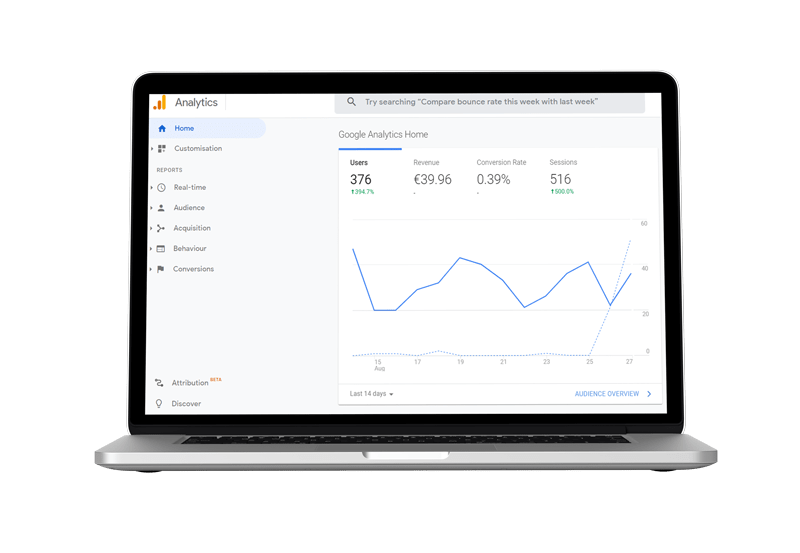Apply for a free consultation

Google Analytics is one of the most important digital marketing tools. It allows each advertiser to answer the most important questions: what is the return on advertising campaigns, and how can I increase sales?
Does any of the following seem familiar?
- I don't know how website visitors interact with the website.
- I want to know which visitor segment generates the most revenue.
- I want to understand which advertising source generates the best results.
- I am curious about what kind of content website visitors like.
- I wonder what improvements should be made to the website.
To resolve this issue, you will need to make additional settings in the Google Analytics tool. These settings will open up a myriad of ways to analyse data that will allow you to make reasoned decisions to improve your business.
Setting conversions or goals
The most important setting to make after successfully installing Google Analytics on a page. Conversion tracking is used to evaluate the impact of advertising campaigns and other sources on sales.
A conversion is a measurable result you want to achieve with your advertising campaigns, which will directly affect your company’s sales.
Conversion can be:
| Purchase | Revenue | Application for consultation | Subscription |
| Call | E-mail collection | Filling the contact form | etc. |
If your business sells online, you need to set up e-commerce tracking. It will allow you to track purchases, income, find out the best-selling products and opportunities to improve the buying process etc.
Analysis of user behaviour
A positive user experience with your website can affect the website’s position in search engines Google, Yandex, Bing, etc., and increase the conversion rate.
Google Analytics offers a myriad of metrics that reflect user engagement on a website.
You can find out:
- on which pages do users spend the most time,
- which pages do users leave most often,
- which device has more engagement on the website,
- which user segment spends time the most in website,
- which pages have the best and worst loading speed,
- how does the loading speed differ between devices,
- etc.
By answering these questions, you will be able to find out what changes – substantive, design, and technical – need to be made on the website. Website development is an ongoing process that allows you to improve your sales without investing in advertising.
This information can also help to understand the audience’s habits and interests, and it can be used for planning other online/offline marketing activities.
Conversion rate optimization (CRO)
Conversion optimization is the process of using information about user behavior to increase a website’s conversion rate.
This information is used to make data-based assumptions about what should be changed on the website: landing page layout, call-to-action button sizes, and colors, checkout process modification, content changes, etc.
During conversion optimization, A/B tests are performed, or users are shown two different versions of the website at the same time. The goal is to find out which version has a greater potential to turn a website visitor into a customer.
Conversion optimisation process
The first step is to define the business goal: increase revenue, number of purchases, number of online forms, number of subscriptions, etc. This goal often matches the goals or conversions set by Google Analytics, but it is always important to make sure you’ve chosen the right goals.
Once the goals have been set, you need to make sure that they are properly accounted for in Google Analytics and other CRO tools. Online stores need to have full e-commerce installed, as it will give an insight into the most viewed items, how many and which items are added to the cart, which are purchased, and for what amounts. This information will be useful in identifying opportunities to improve the buying process.
Page load time: determines how fast pages load on different devices. Long load time negatively affects conversion rate.
Demographics: evaluates whether user behavior varies by gender, age, and location.
Traffic sources: determines the most effective sources based on conversion rates. In this way, professionals will be able to focus primarily on increasing returns directly from these sources.
Dwell time: this will allow you to find out which pages need to improve their content and visualization.
Purchasing process (for online stores): it is studied how many items are viewed, placed in the cart, and bought at the end, as well as the percentage of users who do not move from one stage to another.
If the data collection works accurately and business goals are set, the first hypothesis can be put forward. It usually starts with improving the buying process. Taking into account the data from the website audit on the purchase process, the first hypotheses are put forward.
From the proposed hypotheses, those that potentially have the greatest impact on the conversion rate are selected for implementation. How many tests will run at a time depends very much on the total traffic to the website.
Once the first hypotheses have been selected, a new page design is technically prepared for validation and then launched using Google Optimize, Optimizely, etc. service providers.
Once the AB tests run, monitoring of their effect on results follows. As soon as one of the tests have been successful, it is implemented on the website itself. Also, after the implementation of a successful test, monitoring of results still remains to prevent a negative effect on the conversion rate.


